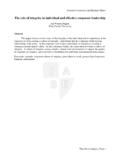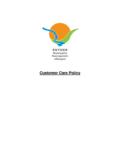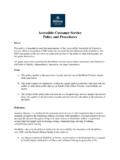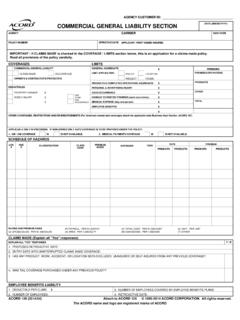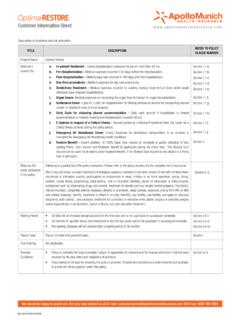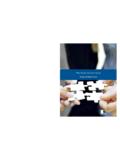Transcription of Customer loyalty: A multi-attribute approach
1 Research in Business and Economics Journal Customer loyalty : A multi - attribute approach J. Barry Dickinson Holy Family University ABSTRACT. The proposed model is theoretically grounded in the multi - attribute attitude literature. It is proposed that the antecedents of Customer loyalty are be partitioned into three categories. First, supply-side (firm-controllable) Customer loyalty antecedents are those satisfaction drivers that comprise total Customer experience (TCE). Eight distinct TCE dimensions are identified through preliminary personal interviews. Second, the TCE variables influence Customer loyalty through a series of mediating variables including satisfaction, quality, perceived value and trust. Customer loyalty is considered a dual-dimensional construct, comprised of cognitive and affective loyalty .
2 The TCE and its antecedents work along two, independent paths---one calculative (cognitive). and one emotional (affective). Third, a demand-side antecedent variable, loyalty Orientation (LO), is developed to account for the effect of individual differences on Customer loyalty . The LO variable is comprised of price fairness, competitor attractiveness, loyalty proneness, and product involvement. Customer loyalty manifests itself in behavioral consequences, including repurchase behavior, spreading positive word of mouth communication, resistance to counter persuasion and reduced product category search. A measure of Perceived Behavioral Control is integrated into the model to account for purchase occasions where the decision is not entirely volitional (exit costs, monetary restrictions, etc.)
3 Managers in virtually any market can use this robust model as a template to optimize loyalty . Keywords: Customer loyalty , Customer experience, affective loyalty , cognitive loyalty , behavioral control, satisfaction, quality, trust, value Copyright statement: Authors retain the copyright to the manuscripts published in AABRI. journals. Please see the AABRI Copyright Policy at Customer loyalty , page 1. Research in Business and Economics Journal INTRODUCTION. The proposed model is theoretically grounded in the multi - attribute attitude literature. It is proposed that the antecedents of Customer loyalty are be partitioned into three categories. First, supply-side (firm-controllable) Customer loyalty antecedents are those satisfaction drivers that comprise the total Customer experience (TCE).
4 Eight distinct TCE dimensions were identified through preliminary personal interviews. Second, the TCE variables influence Customer loyalty through a series of mediating variables (Evaluation Antecedents) including satisfaction, quality, perceived value and trust. The conceptualize Customer loyalty as a dual-dimensional construct, comprised of cognitive and affective loyalty . The TCE and Evaluation antecedents work along two, independent paths---one calculative (cognitive) and one emotional (affective)---leading to Customer loyalty . Third, a demand-side, antecedent variable, loyalty Orientation (LO) is introduced to account for the effect of individual differences on Customer loyalty . The LO. variable is comprised of price fairness and competitor attractiveness (both of which have an inverse effect on cognitive loyalty ); and loyalty proneness and product involvement (both of which have a positive effect on affective loyalty ).
5 Customer loyalty manifests itself in behavioral consequences including repurchase behavior, spreading positive word of mouth communication, resistance to counter persuasion and reduced product category search (only repurchase behavior is examined in the present study). A measure of Perceived Behavioral Control is integrated into the model to account for purchase occasions where the decision is not entirely volitional (exit costs, monetary restrictions, etc.). Managers in virtually any market can use this robust model as a template to optimize loyalty . The context of the study is business-to-business services. STATEMENT OF RESEARCH PROBLEM, CONTRIBUTION, AND RESEARCH. QUESTIONS. The concept of Customer loyalty has a vast, fractious research legacy. A recent search of the ABI/Inform business database for the term Customer loyalty returned over 10,000 results.
6 There should be more agreement and advancement concerning the construct, given it has been over 80 years since the notions of brand preference and brand insistence were first introduced (Copeland, 1923). The core of the problem is that researchers are missing the forest for the trees. Although the need for a broad and holistic Customer loyalty model has been recognized (Dick and Basu 1994), no such model has been empirically tested. Moreover, loyalty research suffers from poor construct definition and incomplete nomological network specification. The present research proposal addresses these gaps in the loyalty research. This research makes a unique contribution to the Customer loyalty literature stream in several ways. First, a topology of company-controllable factors that are utilized by firms to fashion the Total Customer Experience (TCE) is developed.
7 This will provide managers with diagnostic capabilities for understanding which dimensions of the TCE are the most important drivers of Customer loyalty in their specific context. Second, two independent pathways to Customer loyalty were developed---one calculative (cognitive) and one emotional (affective). Managers who are cognizant of the underlying mechanism of loyalty formation in their Customer base can make better strategic decisions. For instance, if customers of a firm are purely cognitively loyal, loyalty strategies that rely on community-building tactics are unlikely to be effective. Third, the present approach takes a holistic perspective of Customer loyalty . Following the pleas of numerous authors, this study integrates competitive, individual, firm-controllable, Customer loyalty , page 2.
8 Research in Business and Economics Journal market-based and important moderator variables into the proposed model. Furthermore, it is calibrated with actual financial data concerning buyer behavior, enhancing the realism of this proposal. The output of these contributions is a roadmap to Customer loyalty . Not only will the roadmap tell the manager how to get to loyalty (prediction) but also how to best get there (explained variance). The dominant research question is what factors are most important in explaining and predicting Customer loyalty given individual, structural and competitive differences? . Underlying this main question, other research questions include: How does partitioning satisfaction into distinct constructs of affective and cognitive satisfaction improve the understanding of Customer loyalty ?
9 How do the new satisfaction constructs affect cognitive and affective loyalty ? How does the integration of the demand-side variables (perceived behavioral control, price evaluations, competitive attractiveness, etc.) improve the model? . HYPOTHESIS DEVELOPMENT AND DISCUSSION. Supply Side Variables-Total Customer Experience Preliminary personal interviews were conducted with business professionals, selected from within the sampling frame, to enhance face validity. These interviews indicated that both satisfaction and loyalty are driven by a relatively well-defined set of characteristics. These characteristics are parsimoniously represented by eight factors: convenience, choice, character, care, cultivation, customization, contact interactivity and communication as depicted in Figure 1. (Appendix).
10 These are conceptualized as the Total Customer Experience (TCE). As noted by Berry, customers always have an experience good, bad or indifferent whenever they purchase a product or service from a company (Berry, 2002).. This study developed working definitions for the preliminary TCE dimensions. Customization represents the extent to which a company can recognize a Customer and tailor the choice of products, services and experience accordingly. Contact interactivity refers to a dynamic, two-way communication conduit between a Customer and a company. Community is the extent to which customers are provided with the opportunity to and ability to share opinions among themselves. Care is the attention that a business pays to all the pre- and post-purchase Customer interface activities designed to enhance Customer relationships.









